
Messiah of Evil is an extraordinary, underseen horror movie from 1974. It’s a film that, despite its low budget and production issues, succeeded artistically. Blending gothic horror with H.P. Lovecraft, Messiah of Evil is, among other things, surreal, creepy, disturbing, terrifying, poetic, and most of all, mysterious. Though it does have a cult following and has received some praise, now, with its recent restoration, there’s hope that this art horror film will finally be discovered by a wider audience and receive the broader recognition it merits.
In 1971, Willard Huyck and Gloria Katz wrote the script for Messiah of Evil in six weeks; the husband-and-wife team had recently completed a treatment for American Graffiti (1973). Messiah of Evil was budgeted for $100,000, and investors agreed to pony up that dough, but in the end, only $85,000 arrived. So, they had to make do. Huyck and Katz later learned the missing $15,000 was taken by a couple of folks as an investors “finder’s fee” and used to put new roofs on their houses.
Messiah of Evil was shot in Southern California in September 1971, with Huyck and Katz co-directing, though Huyck received sole credit. Once principal photography was complete, the filmmakers were shut out of the production. After various delays, Messiah of Evil was finally given a limited release in December 1974.

In Messiah of Evil, a young woman named Arletty comes to a seaside town to visit her artist father. But when she arrives she discovers he’s left, leaving behind words of warning about the community. Soon Arletty meets a trio of outsiders, led by Thom, a suave aristocrat with guru tendencies. Thom’s curious about the town’s folklore, which involves the pending return, after 100 years, of a “dark stranger”—a messiah of evil.
Shot in Techniscope, essentially a more economical version of Technicolor, Messiah of Evil is beautifully lit and photographed. The colors blue and red are prominent, and are often used together. This sort of use of color would be on display in a later, more famous horror film, Suspiria (1977).
The filmmakers were influenced by fine and pop art, the latter apparent in the wall paintings in Arletty’s father’s house.

Messiah of Evil brings to mind other meagerly budgeted horror movies from the 1960s and early 1970s that are also accomplished works: Carnival of Souls (1962), Night of the Living Dead (1968), and Malatesta’s Carnival of Blood (1973). It shares the most similarities with Let’s Scare Jessica to Death (1971). In both films, the story is told from the protagonist’s perspective following traumatic experiences, and after being committed to a mental institution. Thus, the viewer is forced to question the realities being presented. Knowing this, the unsettling dream logic present in these films is enhanced. But in Messiah of Evil, is Arletty really an unreliable narrator? At the end of the film, we get a clue.
There’s no shortage of weird characters in Messiah of Evil, but the albino trucker, strikingly played by Bernie Robinson—in his only screen role—takes the cake.

A post-1960s malaise permeates the proceedings, personified in the undefined relationship between Thom, Laura, and Toni. Seemingly an allegory for the end of the hippie era, this apparent throuple (we never learn exactly what their deal is) symbolizes the death of the free love ‘60s—and now what?
The two most stunning segments, both involving deaths, are ripe for analysis. The first takes place in a supermarket, the second in a movie theater. The former is where we get our first look at the town “ghouls” in action, feasting on raw meat. The scene is surely meant to be a critique of consumerism, and this was years before Dawn of the Dead (1978).
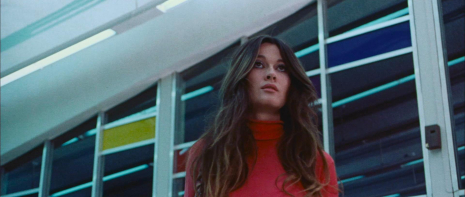
In the theater scene, violent images are watched coldly by the ghouls. Is this a commentary on Americans passively watching footage of the Vietnam War on television? Like many aspects of this film, it is open to interpretation. This is, in part, because the intentions of those who finished the film are unknown.
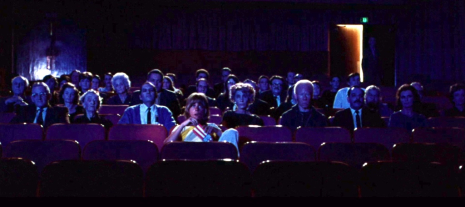
Supermarkets and cinemas are places of comfort and safety, making the scenes all the more unnerving. Both characters are murdered and devoured by the ghouls with the lights on, which is certainly unusual in horror films. This is especially noteworthy in the supermarket, which is bathed in bright light.
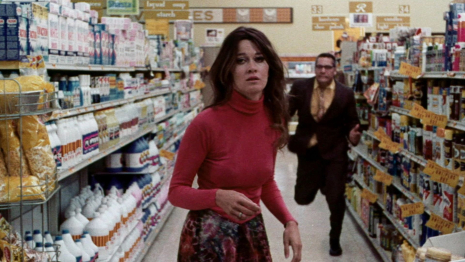
Both segments have a great rhythm to them. The credited editor, Scott Conrad, had no relation to the original production, but it’s hard to argue with the choices he made for Messiah of Evil. Conrad would soon be editing Rocky (1976), and win an Academy Award for his efforts.
These scenes are astonishing, deserving of recognition as hallmarks in horror cinema.
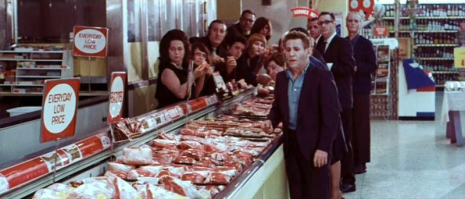
What are these flesh eating ghouls? Zombies? Are they Possessed? Diseased? Members of a murderous cult? Do they have anything to do with the pending return of the dark stranger? They look like they are from another era, specifically the 1950s, a time in America typically viewed with rose-colored glasses. One of the possible themes of the film is that, beneath the veneer of small-town normalcy lies unspeakable horror that infects everyone, eventually.
Admittedly, the conclusion of the film is a bit of a letdown, specifically the dark stranger storyline, which is wrapped up very quickly; a more substantial scene was planned by Huyck and Katz but never shot, due to budget restraints. In the final minutes, we see that Arletty now has a facial scar. Curiously, its partially obscured by strands of her hair, and is often missed by audiences, rendered even less visible on the subpar print transfers that have circulated for decades on home video. But what does the scar indicate? Is it a sign that everything we’ve just seen, as told by Arletty, did happen? Like much of Messiah of Evil, this element is a mystery.

There are quite a few exceptional and interesting independently produced horror movies from the 1970s that are still waiting for genre fans to discover, and Messiah of Evil is certainly one of the best. It has its share of fans—those who know, know—a base that will surely grow by virtue of its fabulous new reissue.
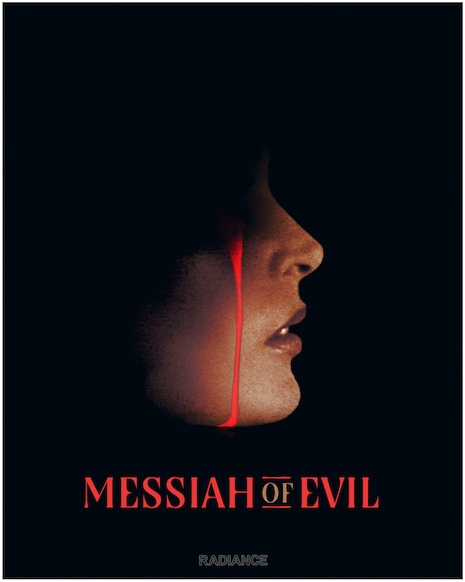
In October, Messiah of Evil was put out on Blu-ray by Radiance Films. The film has been given the 4K treatment—and looks fantastic. Initially offered in a limited edition of 3,000 copies, it quickly sold out. But have no fear, another edition dropped this week. Get all details and pick it up via the MVD Shop; it’s also on Amazon.
Previously on Dangerous Minds:
The surreal nightmare that is ‘70s cult film oddity ‘Malatesta’s Carnival of Blood’
Obscure occult horror film gem, ‘Dark August,’ 1976 (with a DM premiere)
‘Massacre at Central High’: Did this film concerning teen-on-teen violence influence ‘Heathers’?





